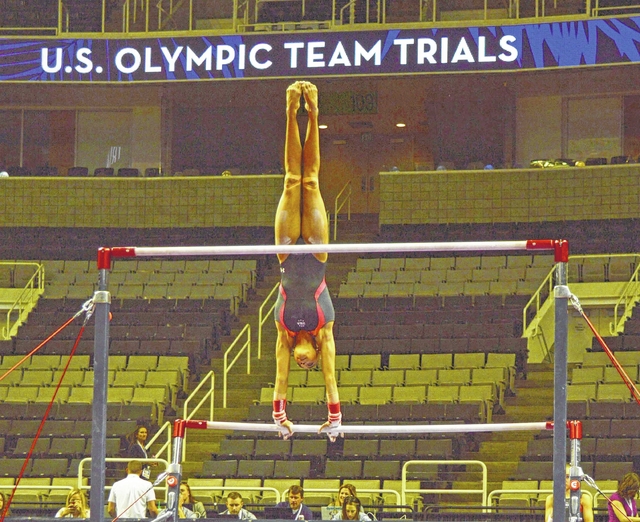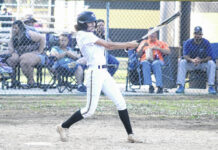SAN JOSE, Calif. — Technically, there are five spots available on the U.S. Olympic women’s gymnastics team that will be unveiled on Sunday night at the end of Olympic Trials. But not really. And Ashton Locklear knows it.
“We all do the math in our heads,” said Locklear who lives in Hamlet and is a member of the Lumbee tribe. “I think you kind of have to. You need to know what’s going on around you.”
Barring injury or a catastrophic drop in form, Simone Biles, Gabby Douglas, Aly Raisman and Laurie Hernandez are heading to Brazil next month.
That leaves one position open — maybe — the one Locklear and good friend Madison Kocian will try to convince national team coordinator Martha Karolyi they’re worthy of during what may be the most important 48 hours of their athletic lives.
No pressure or anything.
“I definitely need to prove myself,” Locklear said. “I definitely need to show consistency.”
It’s a testament to the depth of the powerhouse program Karolyi has built that the only real lingering drama with less than a month to go before the games centers around who will serve as the anchor on uneven bars. The top choices are the fluidly elegant Locklear — who helped the U.S. to team gold in the 2014 world championships — and the precise Kocian — who won gold on her favorite event at the 2015 world championships.
Both provide compelling arguments. Locklear’s cumulative uneven bars score during the two preliminary meets leading up to Olympic Trials was 0.3 better than Kocian’s total. Yet Kocian provides Karolyi with flexibility in the all-around, heady territory considering she broke the tibia in her left leg just above the ankle at the end of February.
“I didn’t really think it was going to be fractured or anything,” Kocian said. “I went to doctor, he told me it was fractured. I melted down. I broke into tears. I didn’t know what that meant for me.”
What it meant for the 18-year-old Texan was two weeks in a cast, another two on crutches while wearing a protective boot and six-plus weeks of limited training while most of the crowded elite field — really, if the U.S. were allowed to field two five-woman teams it would turn the race for gold into an intramural — kept pressing forward.
“I drove myself crazy in the beginning,” Kocian said. “It was really hard. I had to stay off bars 3-4 weeks, I’d never stayed off that long.”
In a way, it may have been a blessing. Sure, sitting for the better part of two months was difficult. It also gave her a chance to recharge mentally, no small thing in a world where the relentless grind of training can wear occasionally wear down bodies and motivation in equal measure.
Kocian believes she’s “more focused than ever,” buoyed by her strong performance at the U.S. championships two weeks ago, where she finished fifth in the all-around thanks in part to a floor routine she and her coaches basically threw together on the fly.
“It was important for her to prove besides being a bars specialist she is a steady competitor on floor and beam,” Karolyi said.
Kocian was planning on vaulting at Olympic Trials but was told by Karolyi not to bother out of fear it may affect her still tender ankle.
“She told my coaches she didn’t want to take any risks,” Kocian said. “She knows it’s not really worth it right now. It’s not really going change my position on the team.”
Kocian isn’t sounding presumptuous, but she knows her best shot at making an impact on a team heavily favored to defend the gold it won so easily in London four years ago is on bars, beam and floor. The vault will be there in case the U.S. should need it.
That’s not the case for the 18-year-old Locklear, whose career path was altered when she fractured her L4 vertebra in 2013. She spent months in a brace and when she was finally cleared soon realized floor exercise and vault weren’t exactly ideal ways for someone with lower-back issues to spend their free time.
So she focused on bars and beam, figuring the extra practice time would give her an advantage. It was a risky strategy, the gymnastics equivalent of a high school senior applying to just one college in hopes of getting accepted.
Locklear is well aware that Karolyi has five women in mind and can name four of them pretty easily. It’s that last one, though, that will be tricky. Maybe it’s Locklear. It’s more likely it’s Kocian. At least, at the moment. And that’s where things can get stressful.
“It’s hard because we’re really good friends and we both want each other to do their best,” Locklear said. “I’m pretty sure she watches me too. We’re competitive with each other but we’re best friends too.”
The friendship will be tested this weekend, though in the big picture the decision will hardly impact the American’s chances of standing atop the podium after team finals on Aug. 9.
The difference between Locklear and Kocian can be measured in small fractions. The U.S. won the 2012 Olympics and 2014 and 2015 world championships by at least five points. Whoever makes the team will likely come home with a gold medal — possibly more than one — in their suitcase.
NBC will carry coverage of the gymnastics trials at 9 p.m. tonight and Sunday’s final day of coverage, including the team announcement, at 8:30 p.m.








